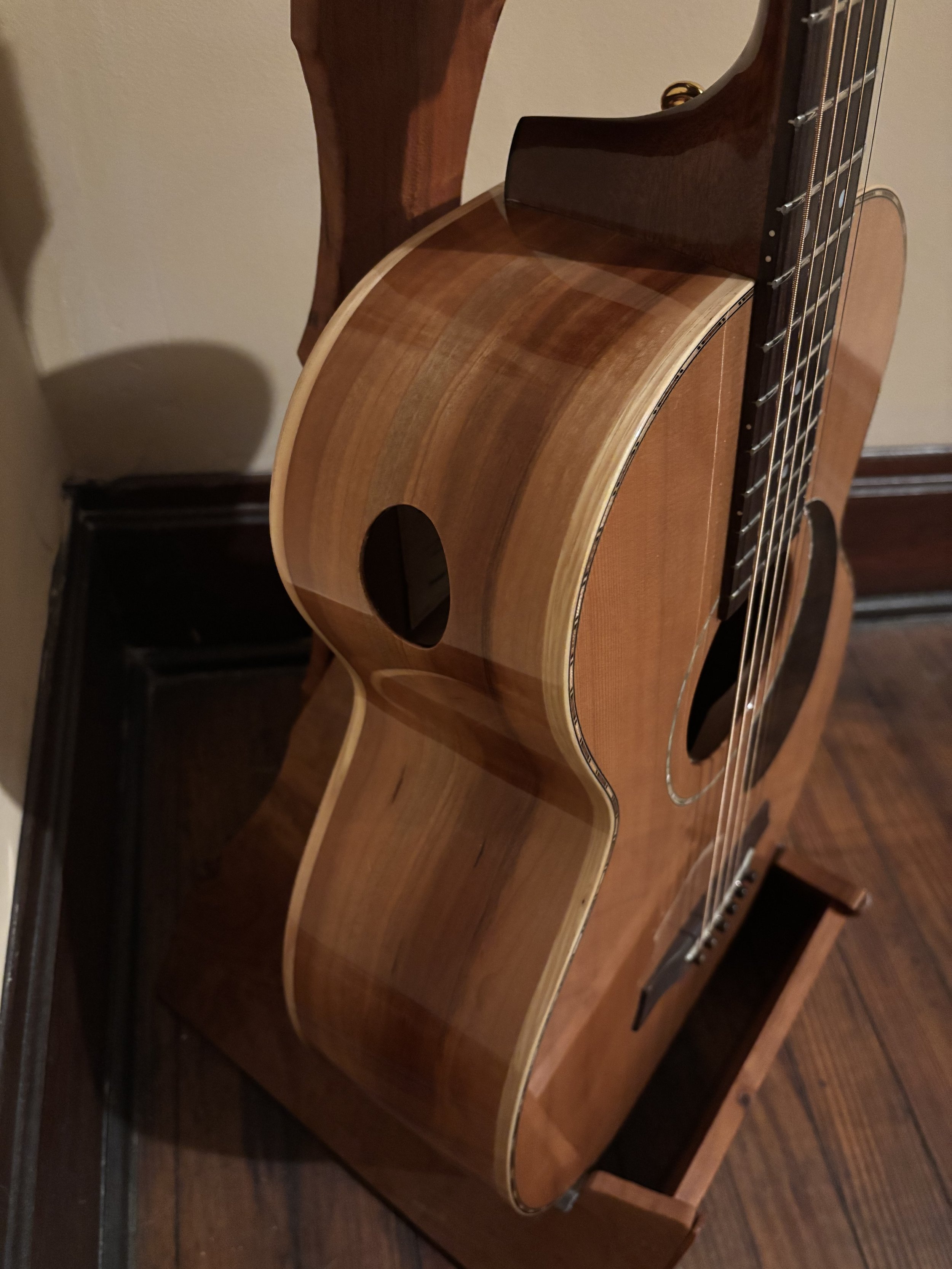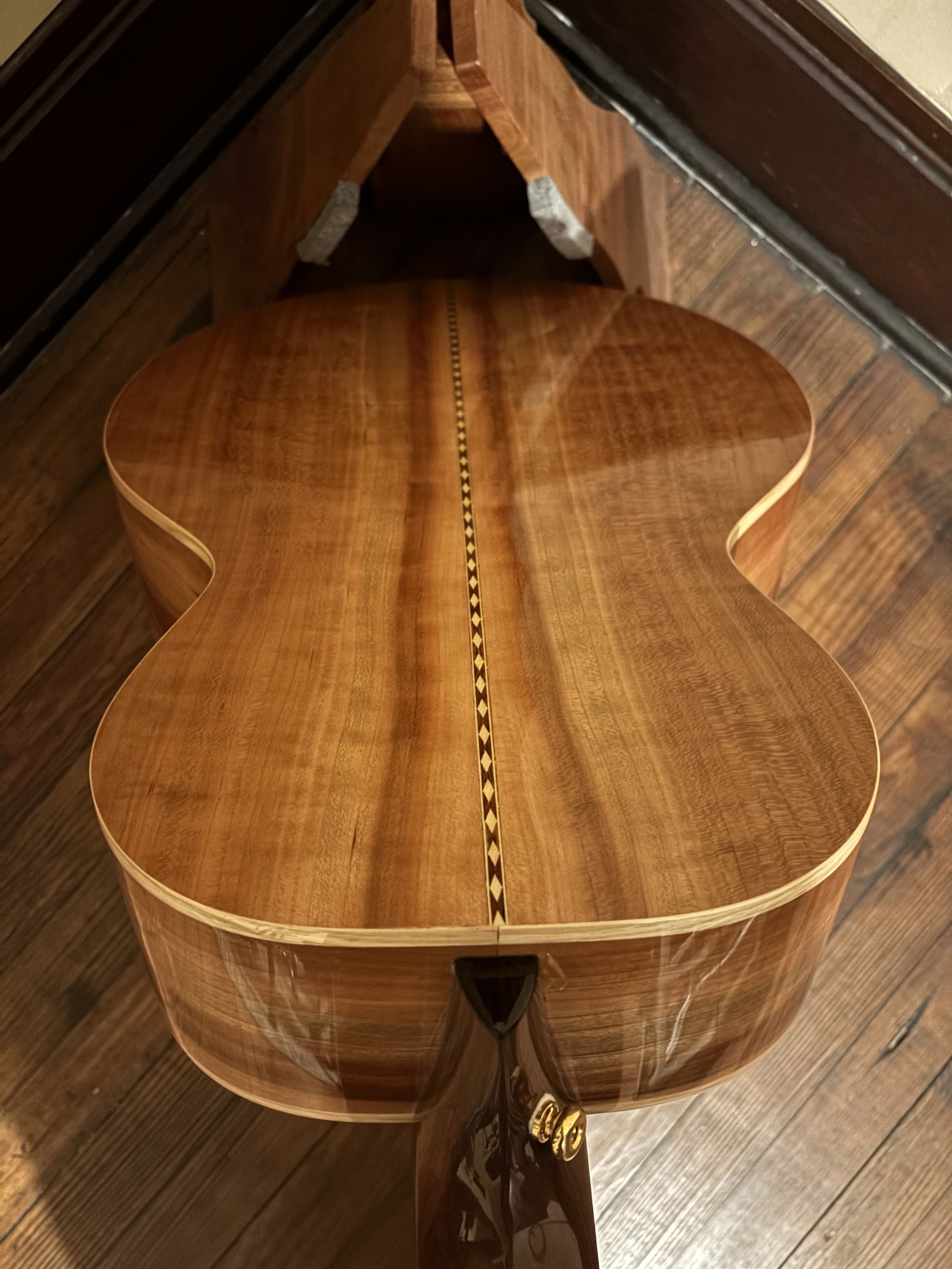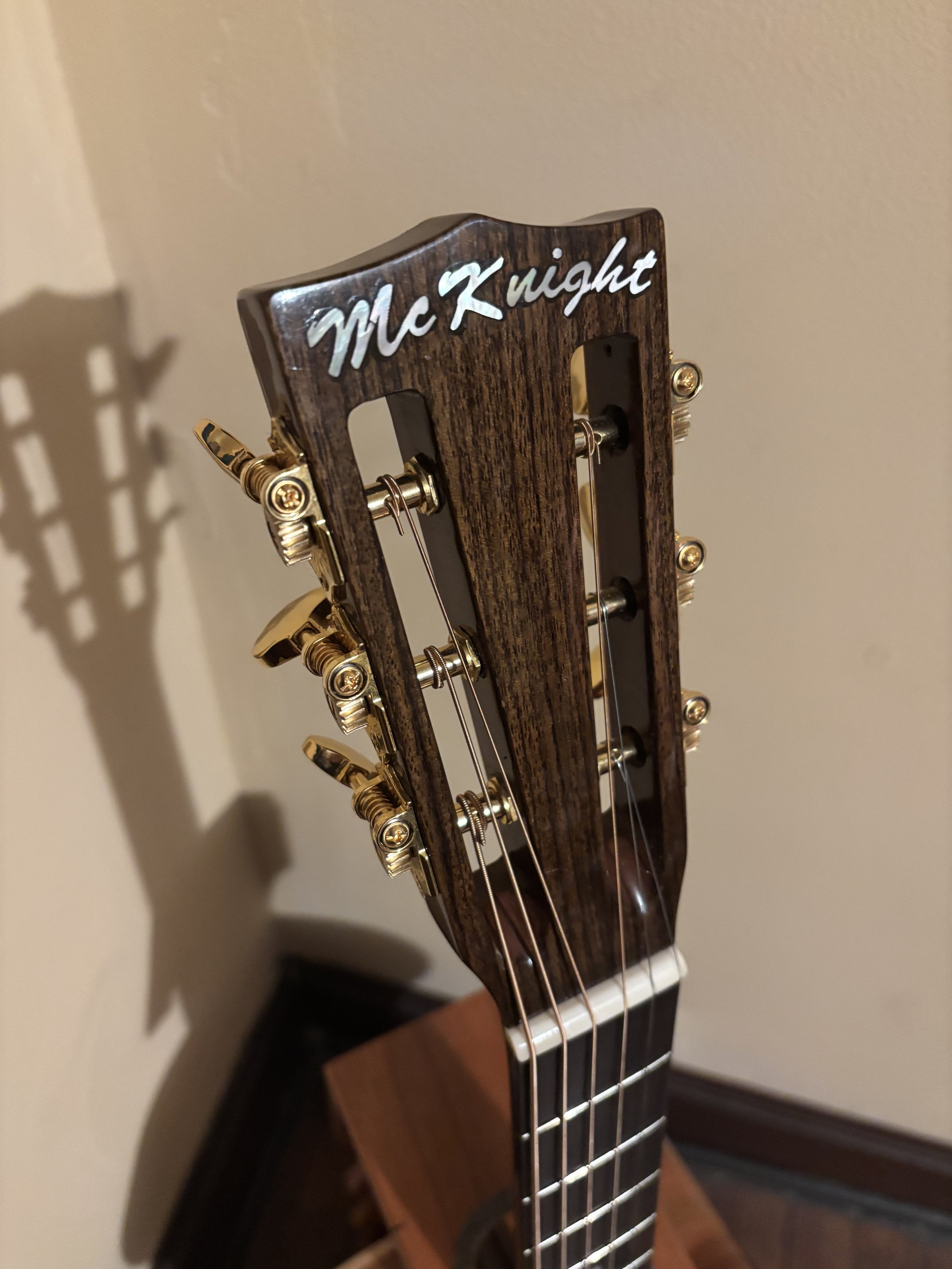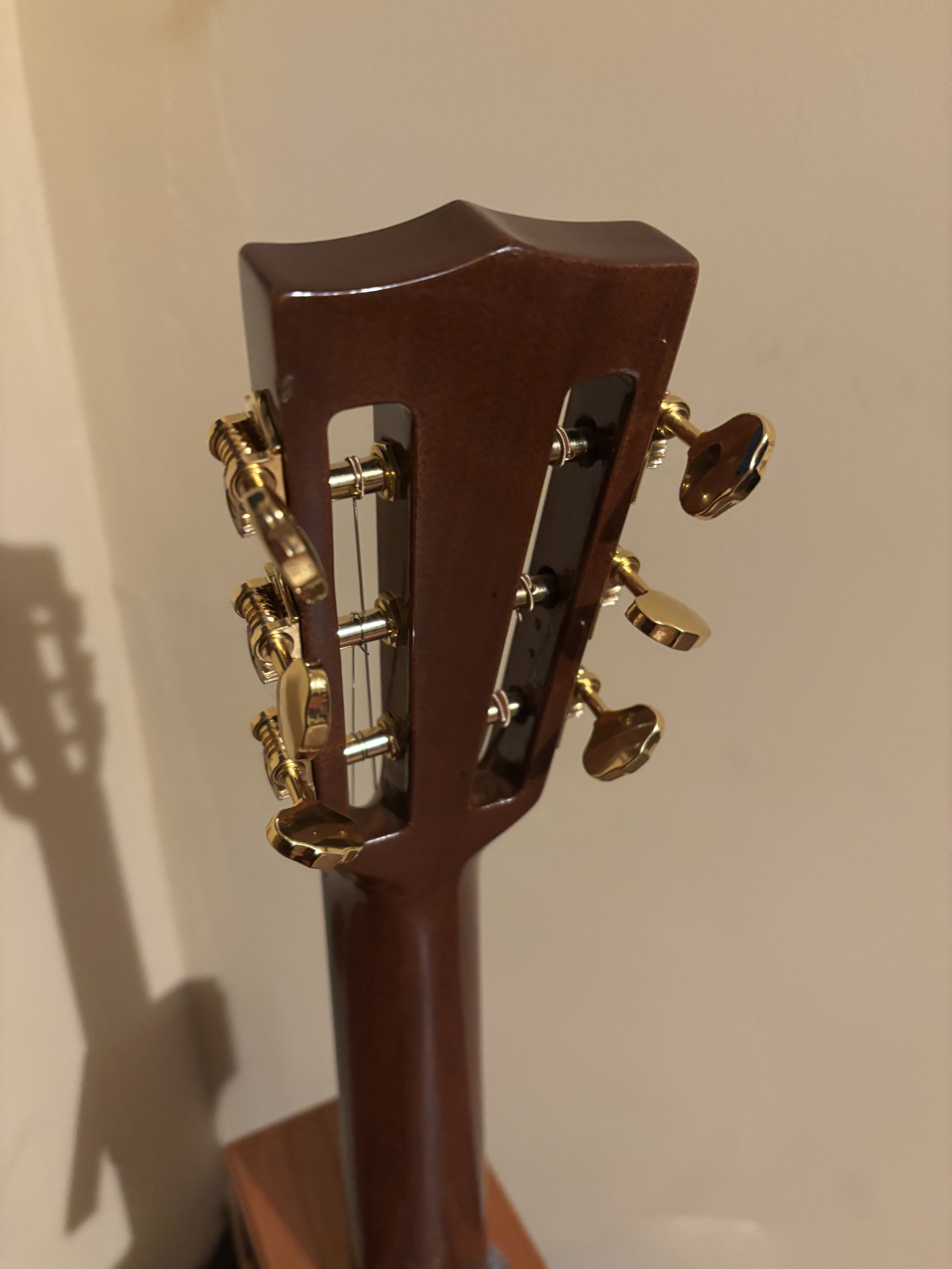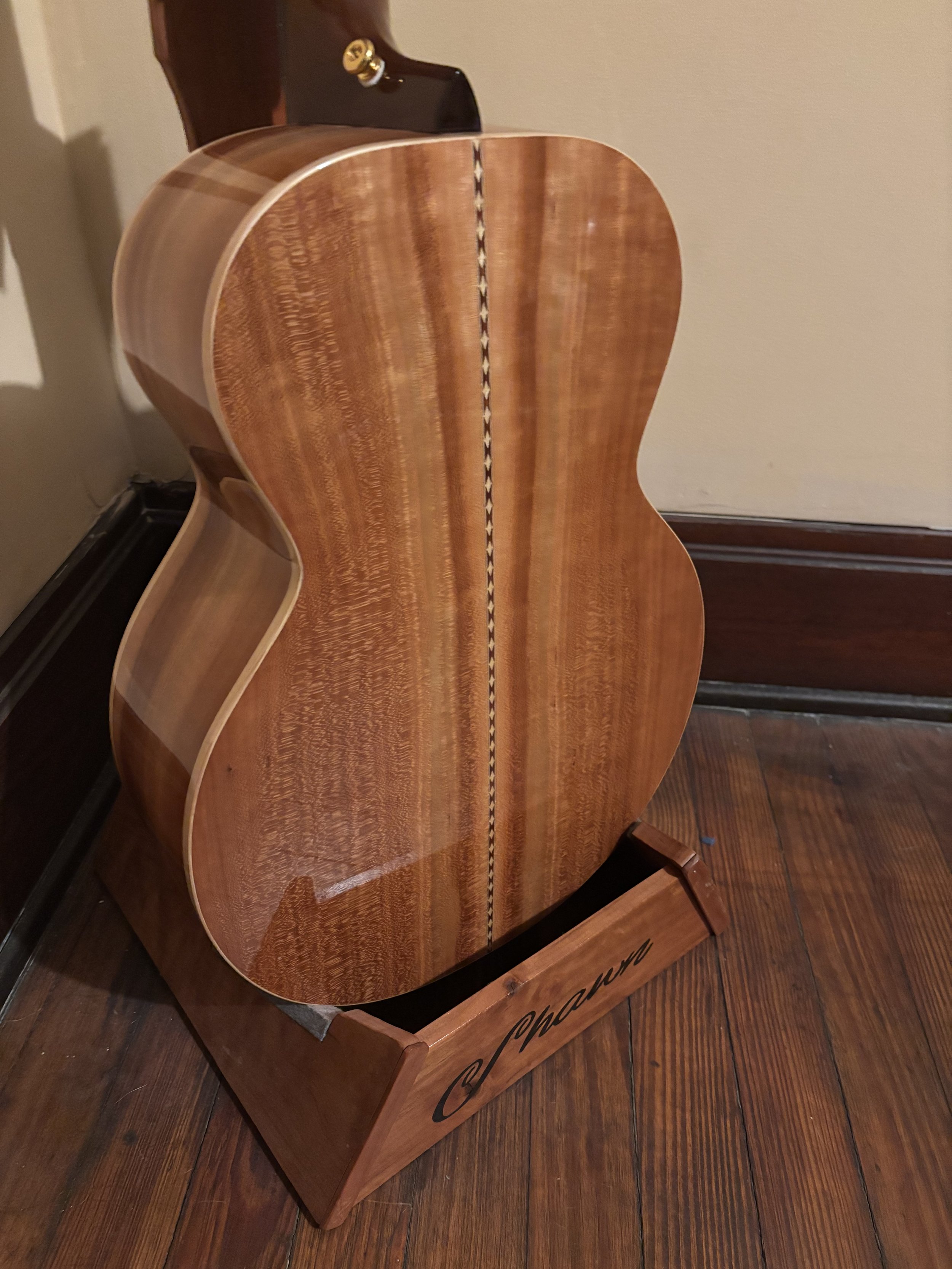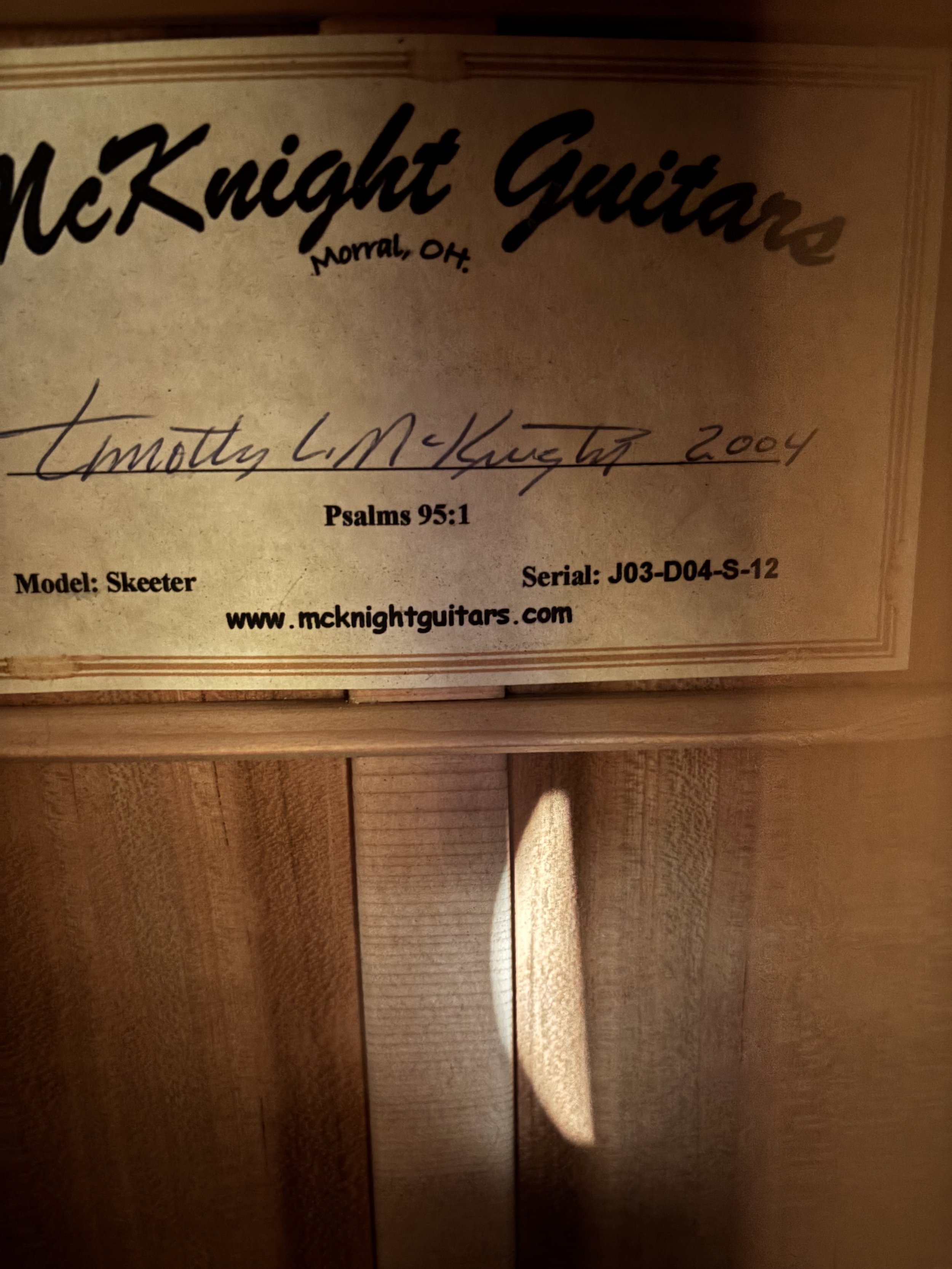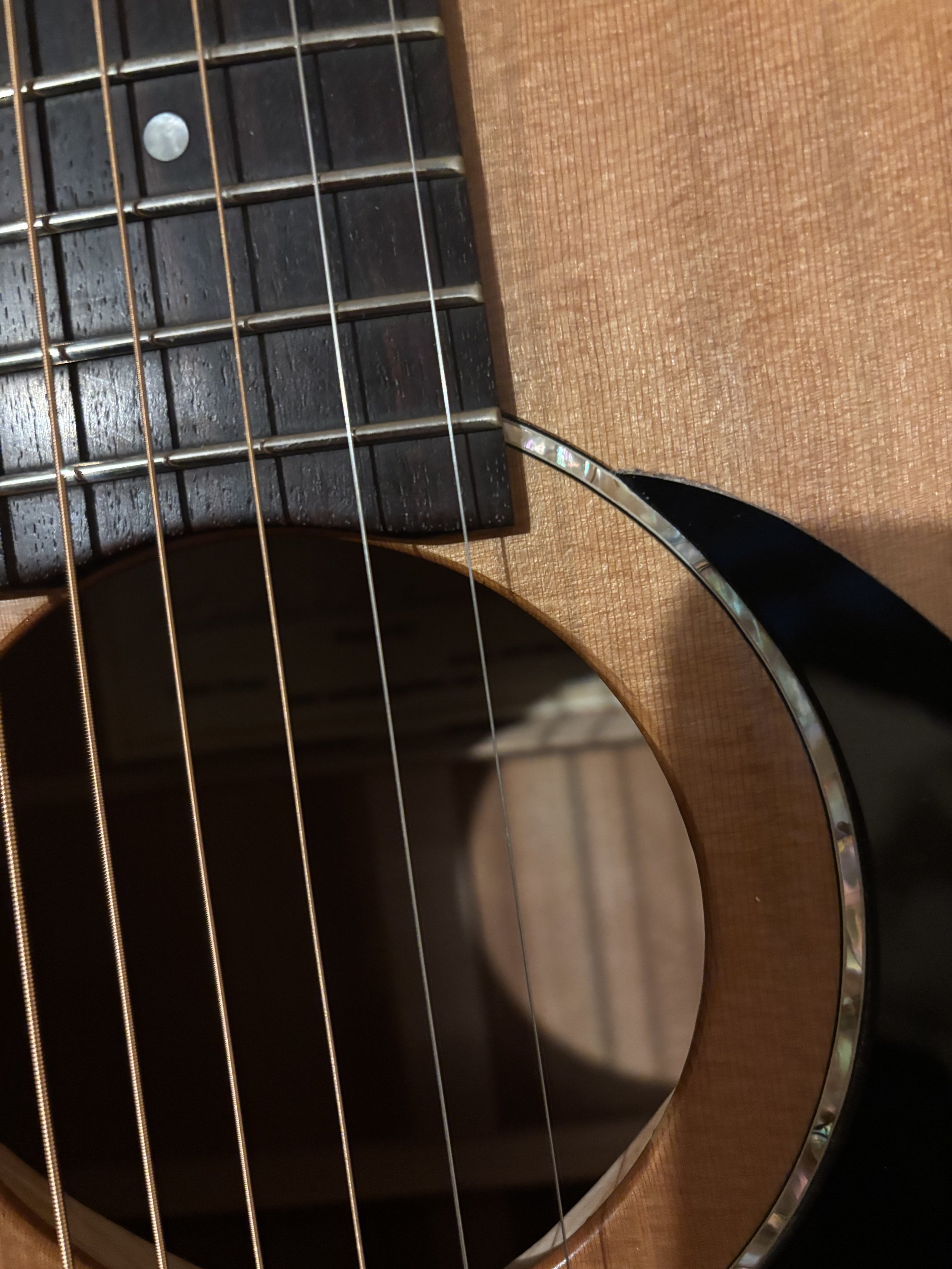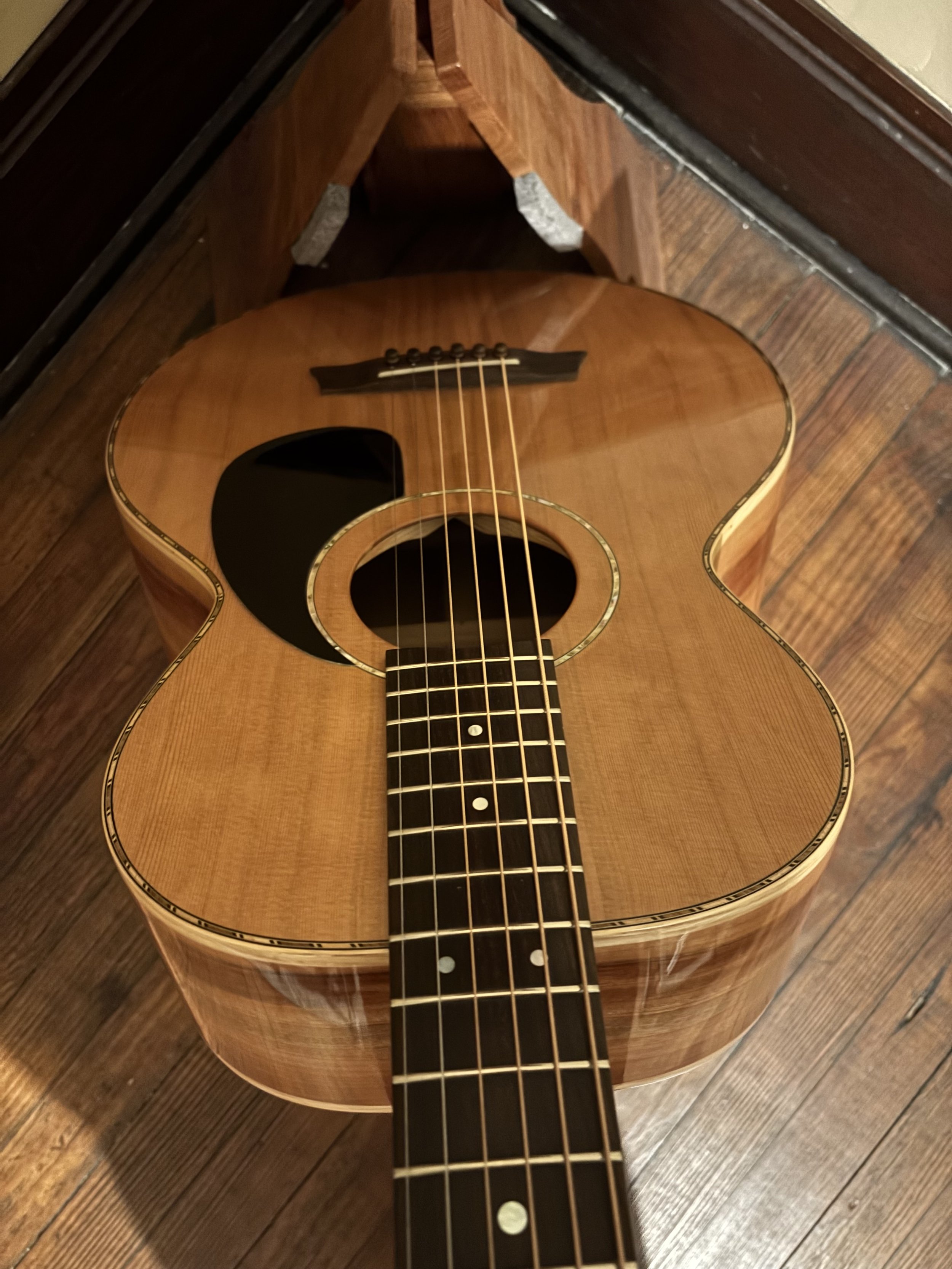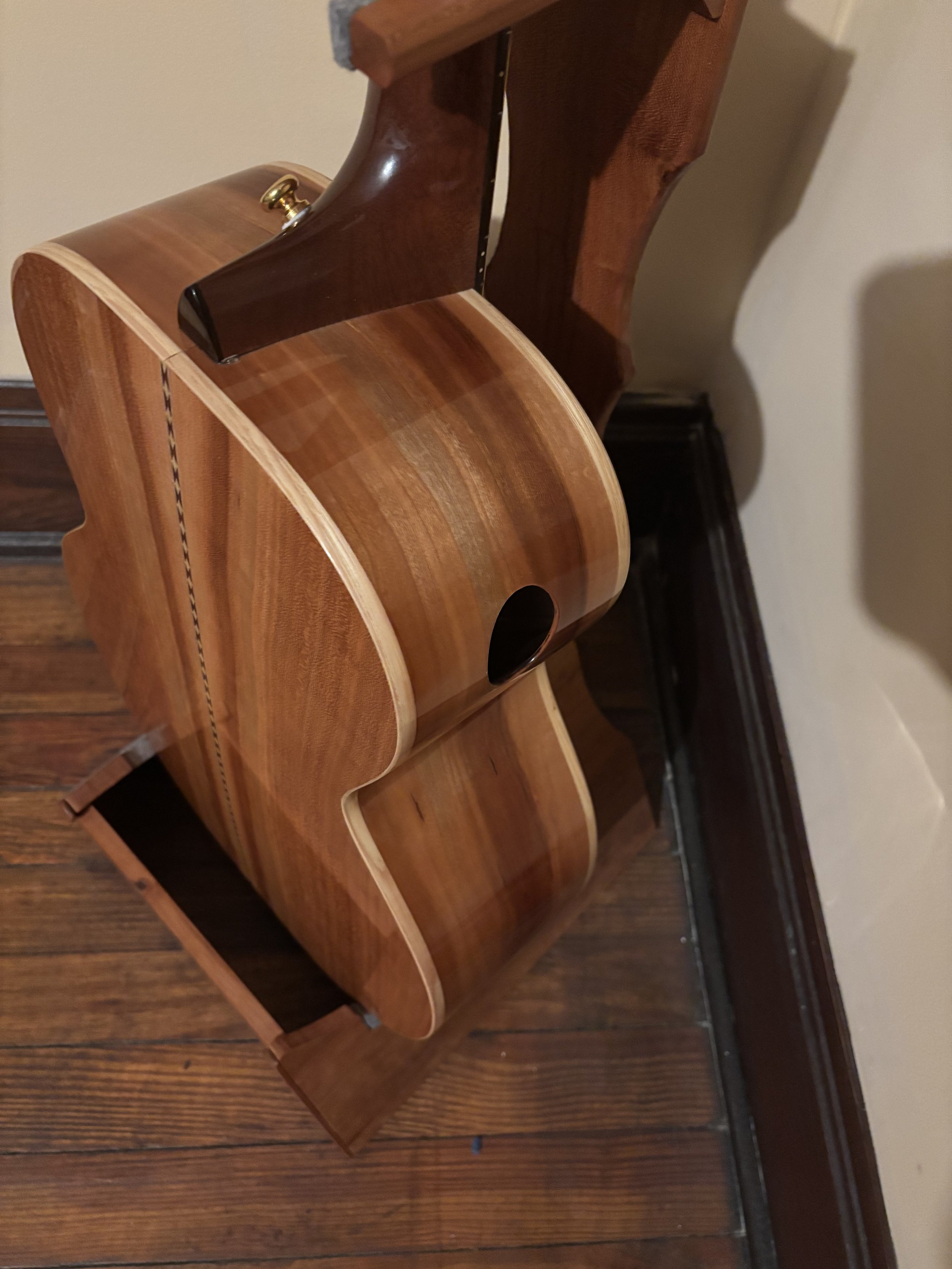Tim McKnight Skeeter
What can we say about the work of Tim McKnight? If there has ever been a veteran in the wonderful world of lutherie, he is in that class. his solo career began in 1992, and spawn from his extensive experiences performing repair/set up work. in addition, he had the opportunity to study building under John Greven and Ervin Somogyi. This model, the Skeeter, demonstrates his great knowledge and application of Acoustic properties, in addition to craftsmanship which is unsurpassable.
Here are some specifications, kindly provided by the owner. “This is Tim’s rendition of the 1926 Gibson Nick Lucas model with 12 frets to the body and I think a 24” scale length. It has premium red cedar top and wild Black Cherry back and sides.
Upper Bout 9.75”
Waist 8”
Lower Bout 13.5”
Body Length 18.75”
Depth at Tail 4.75”-5”
Nut width 1 3/4”
String spacing 2 1/4”
Sound port
Slotted headstock
Cedar Creek arch top premium case.
It is a 2004 original everything except new Grover tuners installed in the last year. It had a fret level and polish and set up at that time.
It has been kept in a humidity controlled room and has a D’Addario HumidiPak in the case with it.
A new Skeeter costs $7500 base with the Cedar Creek case, sound port and slotted headstock as upgrade options adding $900 to the cost so $8400 new”.
As a player, you know when you Are in contact with a masterpiece, as this is. The Skeeter is a wonderfully versatile instrument, with a very rich bass response. with a body depth which resembles a lot of dreadnoughts, this instrument has a great thickness to the sound of each note. however, unlike the dreadnought, lots of players will find a high-level of comfort and versatility when playing on this instrument. it’s rounded shoulders automatically reduce the burden on your rotator cuff, while the deep body provide sonic assistance to you. additionally, the western red cedar top responds to the right hand with very little effort, providing a big sound without having to hammer, beat, bang, or one of my favorite southern words, “sworp”. You will also find a great deal of tone color in a cedar top instrument; Its pallet range is broad, as bright and clear as a rocky Mountain morning, all the way to as dark and luscious as German chocolate. we should also note that unlike some instruments with a sound port, there is not a loss of power out front. Mr. McKnight has the wisdom, and understands that when a port is added, it will increase the resident frequency of the box, and this must be accounted for during construction, to keep from reducing the power and bass response. Regardless of if you are picking at home, or on the stage, the Tim McKnight Skeeter will deliver! Reconsider this instrument to be an excellent plus condition, and one of the best values in a small body guitar that we have seen to date.
Demo video: https://youtu.be/JxMVbC1fGVQ?si=stgpmKgM3yuABPiQ
What can we say about the work of Tim McKnight? If there has ever been a veteran in the wonderful world of lutherie, he is in that class. his solo career began in 1992, and spawn from his extensive experiences performing repair/set up work. in addition, he had the opportunity to study building under John Greven and Ervin Somogyi. This model, the Skeeter, demonstrates his great knowledge and application of Acoustic properties, in addition to craftsmanship which is unsurpassable.
Here are some specifications, kindly provided by the owner. “This is Tim’s rendition of the 1926 Gibson Nick Lucas model with 12 frets to the body and I think a 24” scale length. It has premium red cedar top and wild Black Cherry back and sides.
Upper Bout 9.75”
Waist 8”
Lower Bout 13.5”
Body Length 18.75”
Depth at Tail 4.75”-5”
Nut width 1 3/4”
String spacing 2 1/4”
Sound port
Slotted headstock
Cedar Creek arch top premium case.
It is a 2004 original everything except new Grover tuners installed in the last year. It had a fret level and polish and set up at that time.
It has been kept in a humidity controlled room and has a D’Addario HumidiPak in the case with it.
A new Skeeter costs $7500 base with the Cedar Creek case, sound port and slotted headstock as upgrade options adding $900 to the cost so $8400 new”.
As a player, you know when you Are in contact with a masterpiece, as this is. The Skeeter is a wonderfully versatile instrument, with a very rich bass response. with a body depth which resembles a lot of dreadnoughts, this instrument has a great thickness to the sound of each note. however, unlike the dreadnought, lots of players will find a high-level of comfort and versatility when playing on this instrument. it’s rounded shoulders automatically reduce the burden on your rotator cuff, while the deep body provide sonic assistance to you. additionally, the western red cedar top responds to the right hand with very little effort, providing a big sound without having to hammer, beat, bang, or one of my favorite southern words, “sworp”. You will also find a great deal of tone color in a cedar top instrument; Its pallet range is broad, as bright and clear as a rocky Mountain morning, all the way to as dark and luscious as German chocolate. we should also note that unlike some instruments with a sound port, there is not a loss of power out front. Mr. McKnight has the wisdom, and understands that when a port is added, it will increase the resident frequency of the box, and this must be accounted for during construction, to keep from reducing the power and bass response. Regardless of if you are picking at home, or on the stage, the Tim McKnight Skeeter will deliver! Reconsider this instrument to be an excellent plus condition, and one of the best values in a small body guitar that we have seen to date.
Demo video: https://youtu.be/JxMVbC1fGVQ?si=stgpmKgM3yuABPiQ
What can we say about the work of Tim McKnight? If there has ever been a veteran in the wonderful world of lutherie, he is in that class. his solo career began in 1992, and spawn from his extensive experiences performing repair/set up work. in addition, he had the opportunity to study building under John Greven and Ervin Somogyi. This model, the Skeeter, demonstrates his great knowledge and application of Acoustic properties, in addition to craftsmanship which is unsurpassable.
Here are some specifications, kindly provided by the owner. “This is Tim’s rendition of the 1926 Gibson Nick Lucas model with 12 frets to the body and I think a 24” scale length. It has premium red cedar top and wild Black Cherry back and sides.
Upper Bout 9.75”
Waist 8”
Lower Bout 13.5”
Body Length 18.75”
Depth at Tail 4.75”-5”
Nut width 1 3/4”
String spacing 2 1/4”
Sound port
Slotted headstock
Cedar Creek arch top premium case.
It is a 2004 original everything except new Grover tuners installed in the last year. It had a fret level and polish and set up at that time.
It has been kept in a humidity controlled room and has a D’Addario HumidiPak in the case with it.
A new Skeeter costs $7500 base with the Cedar Creek case, sound port and slotted headstock as upgrade options adding $900 to the cost so $8400 new”.
As a player, you know when you Are in contact with a masterpiece, as this is. The Skeeter is a wonderfully versatile instrument, with a very rich bass response. with a body depth which resembles a lot of dreadnoughts, this instrument has a great thickness to the sound of each note. however, unlike the dreadnought, lots of players will find a high-level of comfort and versatility when playing on this instrument. it’s rounded shoulders automatically reduce the burden on your rotator cuff, while the deep body provide sonic assistance to you. additionally, the western red cedar top responds to the right hand with very little effort, providing a big sound without having to hammer, beat, bang, or one of my favorite southern words, “sworp”. You will also find a great deal of tone color in a cedar top instrument; Its pallet range is broad, as bright and clear as a rocky Mountain morning, all the way to as dark and luscious as German chocolate. we should also note that unlike some instruments with a sound port, there is not a loss of power out front. Mr. McKnight has the wisdom, and understands that when a port is added, it will increase the resident frequency of the box, and this must be accounted for during construction, to keep from reducing the power and bass response. Regardless of if you are picking at home, or on the stage, the Tim McKnight Skeeter will deliver! Reconsider this instrument to be an excellent plus condition, and one of the best values in a small body guitar that we have seen to date.
Demo video: https://youtu.be/JxMVbC1fGVQ?si=stgpmKgM3yuABPiQ



